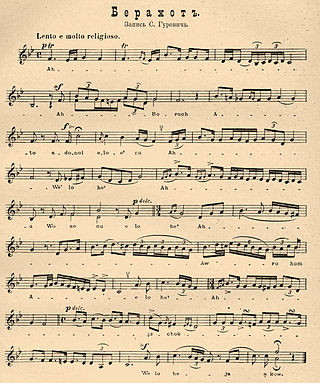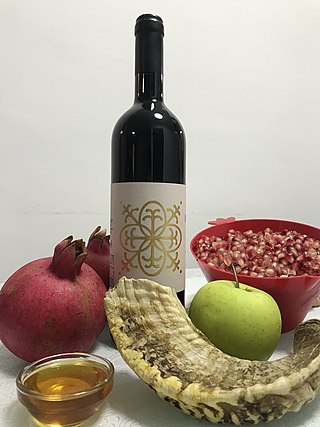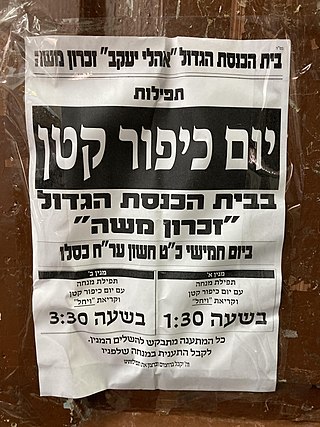
Jewish holidays, also known as Jewish festivals or Yamim Tovim, are holidays observed by Jews throughout the Hebrew calendar. They include religious, cultural and national elements, derived from three sources: mitzvot, rabbinic mandates, the history of Judaism, and the State of Israel.

Sukkot is a Torah-commanded holiday celebrated for seven days, beginning on the 15th day of the month of Tishrei. It is one of the Three Pilgrimage Festivals on which Israelites were commanded to make a pilgrimage to the Temple in Jerusalem. Originally a harvest festival celebrating the autumn harvest, Sukkot’s modern observance is characterized by festive meals in a sukkah, a temporary wood-covered hut, celebrating the Exodus from Egypt.

Yom Kippur is the holiest day of the year in Judaism and Samaritanism. It occurs annually on the 10th of Tishrei, corresponding to a date in late September or early October.
Shemini Atzeret is a Jewish holiday. It is celebrated on the 22nd day of the Hebrew month of Tishrei in the Land of Israel, and on the 22nd and 23rd outside the Land, usually coinciding with late September or early October. It directly follows the Jewish festival of Sukkot which is celebrated for seven days, and thus Shemini Atzeret is literally the eighth day. It is a separate—yet connected—holy day devoted to the spiritual aspects of the festival of Sukkot. Part of its duality as a holy day is that it is simultaneously considered to be both connected to Sukkot and also a separate festival in its own right.

The Amidah, also called the Shemoneh Esreh, is the central prayer of the Jewish liturgy. Observant Jews recite the Amidah at each of three daily prayer services in a typical weekday: morning (Shacharit), afternoon (Mincha), and evening (Ma'ariv). On Shabbat, Rosh Chodesh, and Jewish festivals, a fourth Amidah (Mussaf) is recited after the morning Torah reading, and once per year, a fifth Amidah (Ne'ilah) is recited, around sunset, on Yom Kippur. Due to the importance of the Amidah, in rabbinic literature, it is simply called "hatefila". According to legend, the prayer was composed by the rabbis of the Anshei Knesset HaGedolah. Accordingly, in Judaism, to recite the Amidah is a mitzvah de-rabbanan, i. e., a commandment of rabbinic origin.
Tenth of Tevet, the tenth day of the Hebrew month of Tevet, is a fast day in Judaism. It is one of the minor fasts observed from before dawn to nightfall. The fasting is in mourning of the siege of Jerusalem by Nebuchadnezzar II of Babylonia—an event that began on that date and ultimately culminated in the destruction of Solomon's Temple, downfall of the Kingdom of Judah, and the Babylonian exile of the Jewish people.
Hallel is a Jewish prayer, a verbatim recitation from Psalms 113–118 which is recited by observant Jews on Jewish holidays as an act of praise and thanksgiving.

Shacharit, or Shacharis in Ashkenazi Hebrew, is the morning tefillah (prayer) of Judaism, one of the three daily prayers.
Torah reading is a Jewish religious tradition that involves the public reading of a set of passages from a Torah scroll. The term often refers to the entire ceremony of removing the scroll from the Torah ark, chanting the appropriate excerpt with special cantillation (trope), and returning the scroll(s) to the ark. It is also commonly called "laining".
Maftir is the last person called up to the Torah on Shabbat and holiday mornings: this person also reads the haftarah portion from a related section of the Nevi'im.

In Judaism, the Ten Days of Repentance are the first ten days of the Hebrew month of Tishrei, beginning with the Jewish New Year Rosh Hashanah and ending with the conclusion of Yom Kippur. These days usually fall in September and/or early October.
Mussaf is an additional service that is recited on Shabbat, Yom Tov, Chol Hamoed, and Rosh Chodesh. The service, which is traditionally combined with the Shacharit in synagogues, is considered to be additional to the regular services of Shacharit, Mincha, and Maariv. In contemporary Hebrew, the word may also signify a newspaper supplement.
Chol HaMoed, a Hebrew phrase meaning "mundane of the festival", refers to the intermediate days of Passover and Sukkot. As the name implies, these days mix features of chol (mundane) and moed (festival).
Isru Chag refers to the day after each of the Three Pilgrimage Festivals in Judaism: Pesach, Shavuot and Sukkot.
Special Shabbatot are Jewish Shabbat days on which special events are commemorated. Variations in the liturgy and special customs differentiate them from the other Shabbats and each one is referred to by a special name. Many communities also add piyyutim on many of these special Shabbatot. Two such Shabbats, Shabbat Mevarchim—the Shabbat preceding a new Hebrew month—and Shabbat Rosh Chodesh can occur on several occasions throughout the year. The other special Shabbats occur on specific sabbaths before or coinciding with certain Jewish holidays during the year according to a fixed pattern.
The modern Hebrew calendar has been designed to ensure that certain holy days and festivals do not fall on certain days of the week. As a result, there are only four possible patterns of days on which festivals can fall.

Rosh HaShanah is the New Year in Judaism. The biblical name for this holiday is Yom Teruah. It is the first of the High Holy Days, as specified by Leviticus 23:23–25, that occur in the late summer/early autumn of the Northern Hemisphere. Rosh Hashanah begins ten days of penitence culminating in Yom Kippur, as well as beginning the cycle of autumnal religious festivals running through Sukkot which end on Shemini Atzeret in Israel and Simchat Torah everywhere else.
On Yom Tov the Torah is read during Shacharit services.

Yom Kippur Katan, is a practice observed by some Jews on the day preceding each Rosh Chodesh. The observance consists of fasting and supplication, but is much less rigorous than that of Yom Kippur proper.

The blowing of the shofar is a ritual performed by Jews on Rosh Hashanah. The shofar is a musical horn, typically made of a ram's horn. Jewish law requires that the shofar be blown 30 times on each day of Rosh Hashanah, and by custom it is blown 100 or 101 times on each day.
Speak unto the children of Israel, saying: In the seventh month, in the first day of the month, shall be a solemn rest unto you, a memorial proclaimed with the blast of horns, a holy convocation.












